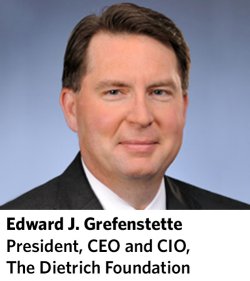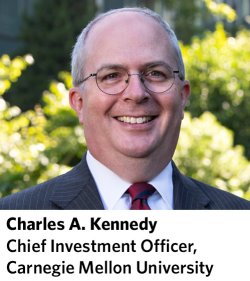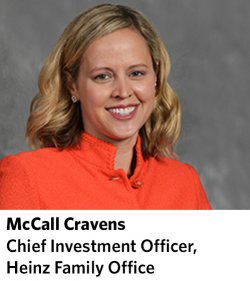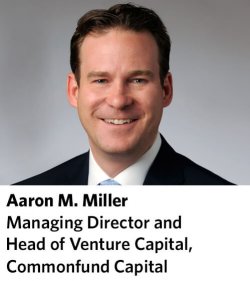Commonfund recently hosted a panel discussion focused on the current state of private equity and venture capital, with an emphasis on the investor’s perspective of the industry today. The three panelists were McCall Cravens, CIO, the Heinz Family Office; Charles “Chuck” Kennedy, CIO, Carnegie Mellon University; and Aaron Miller, Head of Venture Capital, Commonfund Capital. The discussion was moderated by Edward Grefenstette, President of The Dietrich Foundation.

 Edward Grefenstette: We’ll begin with a brief description of our portfolios, so you have a sense of where we’re coming from. Starting with me, Bill Dietrich launched the Dietrich Foundation in 1996 with $170 million from the sale of his steel company. He decided he wanted to give it all away in the tradition of Andrew Carnegie, but not before he died. Bill wanted to grow the assets and did so nicely, to about $500 million when I took over the portfolio in 2010. He lost a battle with cancer in 2011. Since then we’ve given away about $140 million and the remaining assets have grown to just shy of $1 billion. The portfolio is very unconventional in several respects. For one, it has invested about 90 percent of its assets in private strategies. Two, we are unusual geographically in that we have about 42 percent of our total portfolio in Asia, and most of that in venture capital in China. So, our portfolio defies comparison with many institutional portfolios, but that’s how Bill wanted it managed. Chuck, what about Carnegie Mellon?
Edward Grefenstette: We’ll begin with a brief description of our portfolios, so you have a sense of where we’re coming from. Starting with me, Bill Dietrich launched the Dietrich Foundation in 1996 with $170 million from the sale of his steel company. He decided he wanted to give it all away in the tradition of Andrew Carnegie, but not before he died. Bill wanted to grow the assets and did so nicely, to about $500 million when I took over the portfolio in 2010. He lost a battle with cancer in 2011. Since then we’ve given away about $140 million and the remaining assets have grown to just shy of $1 billion. The portfolio is very unconventional in several respects. For one, it has invested about 90 percent of its assets in private strategies. Two, we are unusual geographically in that we have about 42 percent of our total portfolio in Asia, and most of that in venture capital in China. So, our portfolio defies comparison with many institutional portfolios, but that’s how Bill wanted it managed. Chuck, what about Carnegie Mellon?
Chuck Kennedy: I’m the CIO at Carnegie Mellon University (CMU), a role I assumed in 2010 after Ed moved to the Dietrich Foundation. Carnegie Mellon’s history with private equity really started in 2005. Before that, we had very little in private capital or any alternatives to speak of. Then the investment committee turned over and we moved in the direction of increasing the private equity allocation dramatically. Currently, our endowment and other long-term assets stand at $2.2 billion. We can talk about $2 billion being a lot of money, but it only supports about 7 percent of the operating budget at Carnegie Mellon. For some of our academic peers the endowment supports more like one-third or one-fourth of the operating budget. But that means we can withstand more illiquidity and our 50 percent target allocation for privates reflects that. We’re slightly under that for a good reason: our denominator has been growing. One caution I would sound: consultants talk about six to eight years to build a private capital program. I think that’s too short. In my opinion, it takes at least 10 years to get consistent commitments to the marketplace and a mature underlying private equity portfolio.

— Ed Grefenstette
Grefenstette: McCall, let’s hear from you.
McCall Cravens: I manage investment assets for the Heinz Family, and they are predominantly taxable assets. We also manage two small foundations for the family that are separate and apart from another large private foundation. The office is very mature. It’s been around since the 1990s, and the family has been investing in private equity since the ‘90s as well. We have a target of about 25 percent for private investments. Relative to some other programs, we do very little in real assets. Our focus is more on traditional buyout and growth equity types of strategies and is probably in-line with most institutions of our size.
Grefenstette: Thanks, McCall. Aaron?
Aaron Miller: I head the venture program at Commonfund Capital, or CCI. Since its inception in 1988, CCI has invested about $16.5 billion in private equity, venture capital and private natural resources. With respect to venture capital, we have committed about $5.5 billion, and we’re investing from our 12th fund today. We have a global program that is U.S.-led but has meaningful allocations to China, India, Israel and Europe, China being the second largest allocation. We’re a global team with offices in Beijing, London, New York and San Francisco in addition to headquarters in Connecticut. On the private equity side we focus on the small and middle markets and in venture capital we are mostly focused on early stage technology.
Grefenstette: Before we go deeper, let me offer some definitions in order to clarify that when we talk about private equity, unless we point out that we’re talking about a specific type of strategy, we’re talking about the generic term. That would encompass buyout funds, growth equity funds, venture capital funds and even real estate funds that are structured as private vehicles. So, that term, “private equity,” just for consistency of reference, means the entire variety of flavors.
Now that we have our definitions straight and you’ve heard the panelists describe their portfolios and approaches, I’ll begin with Chuck by asking: As you think about the $2.2 billion CMU endowment, what role do you expect private strategies to play in that portfolio?
 Kennedy: To frame it more broadly, we are an equity-oriented portfolio—85 percent equity, 15 percent fixed income. Our goal is growth. The reason we have such an aggressive approach is a 5 percent payout that supports the university and our commitment is to maintain it in perpetuity. Inflation for higher ed runs a full 100 basis points or so north of CPI, which isn’t surprising when you consider that CPI has a lot of things that have been going down in price, like energy and food, whereas in higher ed three-quarters of our expenses are labor . . . and not just any labor, but very expensive, highly educated labor. So, our goal is an 8 percent return and the only way to achieve that is through equity. We think that over a long period of time, meaning over at least a full business cycle, private equity will outperform public equity. We hold that as a fundamental truth, just like the universal faith that equities will outperform fixed income over the long run. In the last 12 months, fixed income did very well. So, there are going to be periods of time when the relationship between privates and publics and fixed income won’t hold, but it’s our view that private equity will be an outperformer over the long term.
Kennedy: To frame it more broadly, we are an equity-oriented portfolio—85 percent equity, 15 percent fixed income. Our goal is growth. The reason we have such an aggressive approach is a 5 percent payout that supports the university and our commitment is to maintain it in perpetuity. Inflation for higher ed runs a full 100 basis points or so north of CPI, which isn’t surprising when you consider that CPI has a lot of things that have been going down in price, like energy and food, whereas in higher ed three-quarters of our expenses are labor . . . and not just any labor, but very expensive, highly educated labor. So, our goal is an 8 percent return and the only way to achieve that is through equity. We think that over a long period of time, meaning over at least a full business cycle, private equity will outperform public equity. We hold that as a fundamental truth, just like the universal faith that equities will outperform fixed income over the long run. In the last 12 months, fixed income did very well. So, there are going to be periods of time when the relationship between privates and publics and fixed income won’t hold, but it’s our view that private equity will be an outperformer over the long term.

— Chuck Kennedy
Cravens: I would echo a lot of what Chuck said. For us and like many of you, we are expecting to receive some sort of illiquidity premium for locking up our capital. We’ll only invest in a private investment fund if we think it will deliver a premium to what we could achieve in the public market in a similar strategy. There are also diversifying benefits to private investments, and there are a lot of inefficiencies in private markets that talented managers can exploit. I also think, importantly, that there are areas of the market that you want exposure to that are more difficult to access with traditional equity investments.
Miller: Similar thoughts. Most of our clients are mission-driven organizations and have return requirements to support those missions. As a result, they’re looking for that illiquidity premium. Another benefit to private strategies is that there can be less correlation than there is in the public market. We target 300 to 500 basis points in excess returns over the public markets. To reach that level, public markets would have to experience a steep rise. That’s unlikely, so our goal is to tap into private market inefficiencies, lock up money for a longer period and be compensated appropriately.
Grefenstette: The role of privates is fundamental to us at the Dietrich Foundation since they account for 90 percent of our assets. We are very focused on the major themes of innovation in all its forms—information technology through health care—as well as the emerging market consumption patterns that are fairly predictable. Bill Dietrich liked to say if you look at the arc of history, every time a country crosses over $8,000 or $10,000 per capita annual income, the consumption patterns look identical. In fact, cross-culturally they look very similar. Protein consumption, health care access, childhood education, interest in entertainment—they all rise. The broad theme that we try to capture in the Dietrich portfolio is innovation in investable opportunities that surface in emerging countries. We believe that’s best done through private strategies.
The panel’s comments have focused on the expected return premium. Aaron, you mentioned 300 to 500 basis points. Chuck and McCall, that sounds appropriate to you. That’s a great segue into a question about today’s environment because no one wants to invest for the future by looking in the rearview mirror. So, let me get into the current market conditions and the impact they might have on your premium expectations. Let me tee up some statistics. To give you a sense of private opportunities versus public opportunities, since 1988 U.S. public market listings have shrunk by 40 percent. Meanwhile, during the same period, the number of U.S. private companies with more than 500 employees has grown 50 percent. In the U.S., there are currently 20,000 private companies with more than 500 employees. Net result: there’s a shrinking pool of investable opportunities in U.S. public equities. When we look at the total amount of private capital under management by dedicated private equity funds of all flavors, that has grown from $600 billion in 2000 to $3.3 trillion today. With that as context, Chuck, how has your thinking changed versus the last five or 10 years regarding the expected return premium?
Kennedy: I think your question gets at valuations, and whether this is a time to invest in private equity inexpensively versus those times when the strategy is overheated and expensive. I don’t think of it that way. In terms of the numbers that you stated, public equity market capitalization has grown but private market cap is under 5 percent that of public cap. So, U.S. public equities are somewhere around $30 to $35 trillion and private capitalization is just under $2 trillion. The question of whether private equity is overheated has to be answered by looking at its merits: a larger investable universe, the ability to go after human innovation in ways the public markets can’t, and alignment of interests between owners, the board, managers and workers. We see these factors as generating the return premium as opposed to relative prices that are being paid in the public market versus the private market.
That being said, your question also alluded to the fact that you can’t access public companies the way you used to. I started off my career as an IPO banker in an era when we could do $100 million IPOs all day. You can’t do that now. Companies are staying private for much, much longer. If you want to access the high trajectory growth curve of those companies, you must do it through the private markets. You can’t do it in the public markets. That’s a structural change that has led to more institutions investing in private markets. That’s what is driving value creation.
Grefenstette: So, you think that the premium that you’ve enjoyed to date in private strategies will persist.
Kennedy: Yes, I believe that.

— McCall Cravens

Cravens: I’m a little bit more pessimistic than Chuck. I think that the private equity industry has matured and has been a very good place to be and it has attracted a lot of capital. In the past, firms bought small companies for cheap prices and used leverage. That was the recipe for success. But I do think valuation matters and it is very high today. As a result, I don’t think that recipe is repeatable in today’s market environment. We talked about not investing by looking in the rearview mirror. But people do behave that way. Right now, natural resources is not in favor. Less than a decade ago it was very much in favor because returns were good. Coming out of the financial crisis venture capital had a rough few years. Today, it is the number one most wanted strategy. Investors are aware of the risks today, but it’s too easy to ignore them and to invest based on what’s worked in the recent past. So, I’m more cautious. The illiquidity premium can still exist, but I believe that returns are going to be compressed across the board for all asset classes over the next 10 years. If you’re used to getting mid-teen to 20 percent IRRs in your private equity portfolio, I think everything shifts down to the left.
Miller: I am going to take the middle road between Chuck and McCall. Clearly, size is the enemy of returns. Are the same inefficiencies that were exploited 10, 15 years ago still there? Probably not. Can you be a generalist in today’s market? No, you need to be a specialist. But let me turn the lens to venture, where we see the opportunity set growing. If you think about how we use and interface with technology, we are at the beginning stages of technology disrupting all industries. In terms of taking advantage of technology, there are more and more companies being built to unseat incumbent organizations, and companies turning to tech to compete and stay relevant—that is only going to increase. So, we think the investable universe is ripe for further innovation and attractive returns. But if you look back to the 1990s you could get 30 percent returns out of private equity or more. Then it narrowed to 25 percent and today it’s closer to 15 percent. But we still think that in venture you can get that 20 percent-plus net return with the right access and portfolio construction.
Grefenstette: That leads to a logical next question: Assuming there is pressure on returns and the illiquidity premium is shrinking, how does that adjust your behavior toward manager sourcing, idea generation and, ultimately, fund selection? Embedded in that is the issue of persistence, which refers to the likelihood that a fund manager who generated, say, top quartile performance in a given fund will achieve top quartile returns in a successor fund. In the 1990s, persistence was significant and that made manager selection like shooting fish in a barrel. If you were a top quartile manager, the probability of your successor fund being a bottom quartile manager was almost de minimis. Jump to today, and the probability of being a top quartile manager and staying a top quartile manager has fallen to about 30 percent. The manager selection process has become much more challenging. Within that context, Chuck, when you think about return compression and more challenging manager selection, how does that inform your team’s behavior?
Kennedy: Great question. I would say the biggest driver is the asset class or strategy. Venture capital has the highest persistence. Real estate is at the other end of the spectrum, this makes sense. Connections—meaning the reputation of the VC firm backing your startup—make a difference in venture. These venture firms have the ability to guide the board through tough decisions on a timely basis to move the company forward. Real estate is a different matter. When you’re looking at a building, how important is it for you to become a tenant based on the money that’s behind that building? The ownership—whether it’s a private or public REIT—doesn’t drive your decision. The value creation is more limited. In sum, the value of the services that are provided by the venture firm are on the higher end but on the lower end with real estate. The persistence is higher with venture capital, lower with real estate and all the other asset classes fall in between.
Cravens: Great point. It’s incredibly difficult because these days you have to kiss a lot of frogs to find one that you like. It comes down to the temptation to raise bigger and bigger funds. This takes managers out of their core competency or core target opportunity set where they know how to fish for opportunities and make money. It also takes away the alignment that may have existed with a smaller fund that had to earn return through carry over a long time period. What we try to do is go back to basic fundamentals and analyze each situation and ask, “Is your process repeatable at this size? Are you aligned with us? What are your motivations? What are your incentives? How hungry are you to generate returns? What is your competitive advantage in this space?” If you go back to those basic questions, it’s pretty easy to flag where issues can arise.
Grefenstette: We’re saying that there’s more work involved in manager selection now than ever before in terms of separating skill from luck and identifying whether a manager can repeat good performance through time. Many are probably thinking about building a book of buyout, venture and real estate strategies. How does one do it internally? Chuck, how are you staffed in order to do the necessary work for idea generation, manager selection and then monitoring?

— Aaron Miller
Kennedy: For us, it has been an evolution. In 2005 when we started the strategy, we relied on consultants. Then we made a number of investments through funds of funds. Gradually, we started to create a more staff-focused model of six professionals, all generalists, which is a model I believe in. Eighty percent-plus of our time is focused on private equity. We spend the bulk of it meeting with managers, understanding the issues they face, visiting portfolio companies, digging into how value is created and doing a lot of networking by participating in meetings like this and talking with other LPs.
Cravens: We have a smaller staff, so the internal model is more difficult. This is a cumulative business built on relationships more than anything. I’ve been trying to create new relationships in this business for 20 years now and we’ve seen it pay off. When you’re small, you have to be realistic about not stretching in places you shouldn’t stretch. We are very intellectually honest in saying, “We’d like to build our own direct relationships, but in venture capital, for example, we have continued to maintain some fund-of-funds exposure for the core of the portfolio because we recognize that’s how we can access marquee managers.”
 Miller: I live and breathe venture, it’s what I talk about every day. We have weekly meetings with our teams in the U.S., Beijing and London. And we spend time in those markets. Last year I think it was 60 some days in China, India, Israel and Europe. So, it takes a lot of time to be in front of those managers and build those relationships, and even then, we think about it in 10-year timeframes. It’s not a meet and greet, it’s all about taking time, making the commitment and putting your resources behind it.
Miller: I live and breathe venture, it’s what I talk about every day. We have weekly meetings with our teams in the U.S., Beijing and London. And we spend time in those markets. Last year I think it was 60 some days in China, India, Israel and Europe. So, it takes a lot of time to be in front of those managers and build those relationships, and even then, we think about it in 10-year timeframes. It’s not a meet and greet, it’s all about taking time, making the commitment and putting your resources behind it.
Grefenstette: Bill Dietrich liked to say, “You can’t shoot moose from the lodge.” You need to be on the ground to collect raw data and spend a lot of time with the managers. As McCall said, it’s a relationship business.
Kennedy: A lot of organizations with smaller pools of money can’t hire a staff the way a large endowment or foundation can. But you can get exposure to this asset class through funds of funds. I would counsel folks not to overlook governance. At CMU we put in place an investment policy statement that made sure people knew this was a long-term commitment. It’s a decade-long decision. Board members are key too. They are at the top of the governance structure, making them absolutely key with respect to asset allocation and the overall risk profile of the portfolio. We could not implement our investment process without their full involvement. That said, the manager selection decision rests with the staff as opposed to it being a top-down process.
Cravens: Same with us. Our trustees don’t view their role as generating investment ideas but I will take an idea wherever I can find it. We have a very collaborative dialogue and we’re constantly talking about the pipeline and ideas. But the trustees’ primary role is asset allocation and overall governance.

